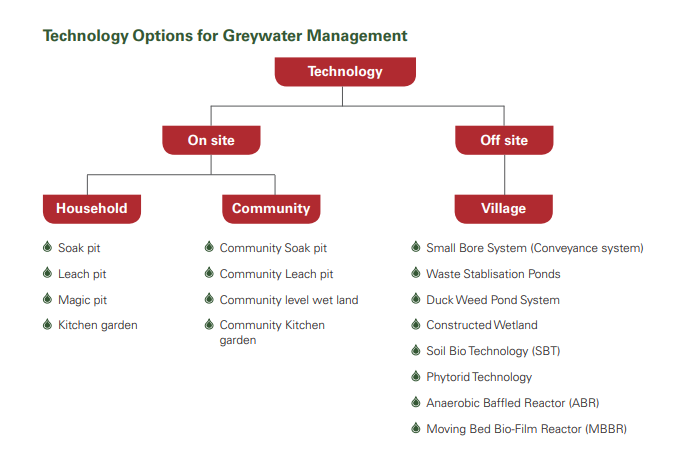‘Sujalam 2.0’ Grey Water Recycling Project | 25 Mar 2022
For Prelims: Grey water, AWCs, SBM-G Phase II, MGNREGS, Sustainable Development Goal, Jal Jeevan Mission, Jal Shakti Abhiyan.
For Mains: Issue of Water Crisis and steps that need to be taken.
Why in News?
On the World Water Day (22nd March), the Ministry of Jal Shakti launched a countrywide project to reuse grey water, or run-offs from kitchens, bathing and laundry.
What is Grey water?
- Grey water is defined as wastewater that is produced from household processes (e.g. washing dishes, laundry and bathing).
- Grey water can contain harmful bacteria and even faecal matter that contaminates soil and groundwater.
- So far, India does not have a focused policy framework for management and usage of grey water in urban and rural areas. However, some guidelines for treatment of wastewater do exist.
- For example, the Central Public Health and Environmental Engineering Organisation (CPHEEO) has specified permitted discharge standards for treated water; use of treated wastewater in agriculture and horticulture (MoHUA, 2012).
- The Central Ground Water Board (CGWB, 2000) directs that treated wastewater can be used as a source of artificial ground water recharge once it meets standards and is compatible with existing groundwater.
What is ‘Sujalam 2.0’ Grey Water Recycling Project?
- About:
- The campaign would focus on the creation of institutional level greywater management assets in Panchayat Ghar, healthcare facilities, schools, Anganwadi Centres (AWCs), community centres and other government institutions.
- Creation of individual and community greywater management assets will be encouraged.
- With active participation from all States and local communities’ great success was achieved under the Sujlam 1.0 campaign which was started in August 2021.
- More than 1 million soak pits were built at household and community level across the country.
- Funding for the Project:
- The funds to execute the activities for greywater management will be sourced from Swachh Bharat Mission Grameen Phase-II or through 15th Finance Commission tied-grants or MGNREGS or through convergence of all.
What is the Need to Address the Grey Water Crisis?
- Saving on fresh water use can significantly reduce household water bills, but also has a broader community benefit in reducing demands on public water supply.
- Reducing the amount of wastewater entering sewers or on-site treatment systems.
- 2.2 billion people across the world are facing a water crisis.
- Sustainable Development Goal 6 aims to provide universal access to safe and clean drinking water and sanitation.
- It is estimated that 31 billion litres of greywater is generated every day in India.
- Under Sujlam 2.0 campaign, over 6 lakh villages will see intense activity on solid and liquid waste management.
- In the present context, a lot of water will flow out of rural households.
- 6 Crore tap water connections have been provided under Jal Jeevan Mission since its launch in August 2019.
- A total of 9.24 Crore households in the country have access to water through taps.
What are the Related Initiatives?
- India:
- Jal Shakti Abhiyan:
- Launched in 2019 to cover water stressed districts, in 2021 it was taken to all rural and urban districts.
- Atal Bhujal Yojana:
- Launched in 2019, it is being implemented in select areas of 7 States wherein the people prepare their water security plan detailing out how they are getting water, amount of water being consumed, type of water conservation method applied and how one can moderate its usage.
- Jal Shakti Abhiyan:
- World:
- The Global Water System Project, which was launched in 2003 as a joint initiative of the Earth System Science Partnership (ESSP) and Global Environmental Change (GEC) programme, epitomises global concern about the human-induced transformation of fresh water and its impact on the earth.
Way Forward
- There is a need to develop sustainable behaviour practices to conserve water.
- The central government should take measures to set up water purification or Reverse Osmosis (RO) plants on an urgent basis to tackle the issue of contamination of drinking water.

